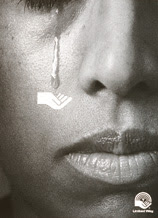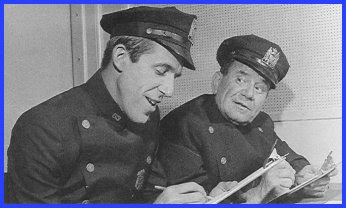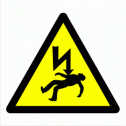
United Way of the Lower Mainland has been linked to “political psychiatry” comparable to that practiced in China and the former Soviet Union, according to the ad hoc group Canadians Opposing Political Psychiatry [COPP].
Accusations of political psychiatry began after a police complaint was lodged by Ron Dumouchelle, CEO of United Way of the Lower Mainland, in Dec. 2002 against a Vancouver woman. Dumouchelle wanted police to press the woman -- we'll call her the whistleblower -- to stop making a Report on United Way available to major donors. Dumouchelle would eventually admit to police that he knew this was "not a criminal matter" and that he had recruited them because the civil court process would be too slow for him. His police complaint, though, resulted in Constables Lee Patterson and J.P. St. Amant writing a police report rife with fabricated and misrepresented evidence on Dec. 18, the day they met with Dumouchelle and anonymous witnesses at United Way Campaign headquarters. (See earlier post, "Fraudulent Evidence Found in United Way Police Complaint".)
The whistleblower fought back.
She faxed St. Amant a memo announcing her intention to seek a fraud/public mischief investigation. She sent a copy of the memo to Dumouchelle. Inspector John de Haas of the Vancouver Police had told her she was entitled to request a public mischief investigation. St. Amant labeled the faxed memo, "the Public Mischief letter". It is the actions of Dumouchelle and St. Amant, though, in response to the "public mischief letter" that have led to accusations of political psychiatry.
A problem for United Way and the VPD: the whistleblower knew her rights
In addition to the whistleblower's assertion in the "public mischief letter" that she intended to seek an investigation into fraud and public mischief, she made reference to her earlier assertion that she would be exercising her right not to speak to police. That assertion had occurred via a voice mail she left for St. Amant on Dec. 20 in response to police hounding her by showing up at her door, talking to her neighbor, and leaving voice mail messages for her. St. Amant received the voice mail, told Dumouchelle about it and made notes on it in his Dec. 21 report: “[Whistleblower] called BC Civil Liberties and was instructed not to talk to police.” St. Amant appeared to initially recognize that right, noting in his report that he had left the whistleblower a response voice mail: “PC 2010 stated that [whistleblower] is free not to talk to police ….” But even after the whistleblower's refusal to talk to police, St. Amant remained under pressure from Dumouchelle to stop the circulation of the Report on UW which Dumouchelle felt could reduce campaign donations.
Dumouchelle may have been nervous about the whistleblower's intent to seek a criminal public mischief investigation as he wasted no time in trying to reach St. Amant after learning of it. The two had a telephone conversation about the "Public Mischief letter" on Boxing Day, according to St. Amant’s report dated Dec. 26th. “These guys had barely digested their Christmas dinner,” exclaims the whistleblower, “when they were on the phone talking about me.”
“PC 2010 returned call from Dumouchelle whom advised PC 2010 that he received a copy of the Public Mischief letter as well.”
Car 87 visit arranged under fraudulent pretenses
Just minutes after his Boxing Day conversation with Dumouchelle, St. Amant was on the phone arranging a visit to the whistleblower’s home by police “Car 87”. Car 87 is a marked police car staffed by a constable and a psychiatric nurse. They are granted the extraordinary power to disregard an individual’s civil liberties and enter their home to assess them for “apprehension” to a mental hospital. “How convenient,” says the whistleblower. “I’d invoked my right not to speak to police and Car 87 was a way they could circumvent that right." But there was one problem: this case did not come anywhere close to meeting the criteria for a Car 87 visit.
Car 87 visits are restricted by legislation to individuals at “imminent” risk of physically harming or killing themselves or others. This fact was confirmed by Jan Fisher, Director of Client Relations at the Vancouver Coastal Health Authority, in a telephone call about a similar case a month earlier, a call which was taped by an advocate and passed on to Canadians Opposing Political Psychiatry. Fisher added that Car 87 is for “extreme emergencies” in which “the public” is at risk of physical harm. This confirmation by Fisher supports the whistleblower's claim that Car 87 was ordered under "fraudulent pretenses".
Prior to the Car 87 visit being ordered, St. Amant, Patterson, and Dumouchelle had repeatedly confirmed, according to the police report, that the whistleblower posed “no physical risk”. Constable Patterson wrote in his Dec. 18 report, “No signs of direct threats or suggestion of violence to person/property.” After a conversation with Dumouchelle, St. Amant noted in his Dec. 18 report that Dumouchelle “agrees” that safety “is not perceived as an issue.” St. Amant reiterated this point in his Dec. 21st report after a follow up conversation with Dumouchelle: “No safety concerns….” In fact Constables Patterson and St. Amant, in their typewritten reports based largely on conversations with Dumouchelle, stated 15 times in the week prior to arranging the Car 87 visit that the whistleblower posed no safety risk.
One entry made by St. Amant on Dec. 21 is adequate though, according to the whistleblower, to substantiate her position that the Car 87 visit was ordered under fraudulent pretenses: “At this time there is no evidence to substantiate [whistleblower] being a physical threat.” That was five days before Car 87 was ordered. What could possibly have occurred over the next 5 days to justify ordering a Car 87 visit on Dec. 26th? Just one thing is on record as having occurred: Dumouchelle and St. Amant received a fax of the “Public Mischief letter” from which they first learned of the whistleblower’s intent to pursue a criminal investigation into the unfounded police complaint and accompanying falsified evidence.
Until the “Public Mischief letter” left Dumouchelle and St. Amant in a jam, St. Amant repeatedly noted in his report that he and Dumouchelle agreed that the proper “strategy” for dealing with the whistleblower would be a civil court injunction. In fact, five days before Car 87 was ordered, St. Amant reiterated in his report, after a conversation with Dumouchelle on Dec. 21, that a civil court injunction would be the “appropriate” approach to handling this case. Even at the moment Car 87 was being ordered on Dec. 26, Dumouchelle continued to view an injunction as the appropriate approach but was frustrated by the fact that one would not be delivered quickly enough, according to St. Amant's report. “If these guys thought I'd be receptive to an injunction," says the whistleblower, "they must have seen me as a sane person."
Whistleblower alleges that the Car 87 visit was politically motivated
The fact that the motivation for ordering the Car 87 visit was political is supported by the fact that the sole evidence turned over to Car 87 was the “Public Mischief letter” in which the whistleblower had stated her intent to seek a criminal investigation. “What better way to send me a message,” says the whistleblower.
Targeting her for a Car 87 visit, the whistleblower believes, was also an attempt to ensure that she would not be taken seriously when pursing a public mischief complaint. St. Amant wasted no time in ensuring she had a Car 87 record on the police computer system where any officer formally taking her public mischief complaint would see it. On Boxing Day, he wrote:
“PC 2010 forward recent letter from [whistleblower] to Car 87 and has requested a
memo be placed for Car 87 concern. PRIME report updated…PC 2010 request an assessment of [whistleblower] by Car 87.”
The term “PRIME” refers to the police computer system. St. Amant made this entry despite having confirmed that there was nothing in the whistleblowers medical history to indicate that she had ever been treated for psychiatric issues.
There is no doubt that a Car 87 visit can severely harm a targeted individual’s credibility. Even if cleared, a targeted individual is left with a “DISTURBED PERSON” notation adjacent to their name on the police PRIME computer system – for life. But here’s the catch: the targeted individual is never actually cleared. The best outcome the targeted political activist can achieve is that the Car 87 psychiatric nurse puts a check mark beside the section of the official form indicating that the individual is not a candidate for apprehension “at this time.” At this time. “COPP is right,” says the whistleblower. “This is the way dissidents in China are treated.”
Dumouchelle was waiting for an update after the Car 87 visit
The whistleblower was outraged to learn from the police report that Dumouchelle at United Way was waiting to be briefed after the Car 87 visit. She had read the following passage entered by St. Amant in his Dec. 26 police report as he was ordering the Car 87 visit:
“PC 2010 advised Dumouchelle that police are continuing to attempt to make
personal contact with [the whistleblower] and will advise when they have in order
to inform her of events and make an assessment as to her well being.” [italics added]
The whistleblower says, “My rights are being overridden and a United Way bureaucrat is waiting for an update.”
Dumouchelle was quoted as providing the reason for the Car 87 visit
It is going to be difficult for United Way to adopt a ‘blame the cops’ defense in response to accusations of an unfounded Car 87 visit that had the earmarks of political psychiatry. After once again noting that Dumouchelle had expressed concern that the civil court process could not meet his need to quickly silence the whistleblower, St. Amant finished the sentence by revealing that it was Dumouchelle who had provided the reason cited for getting Car 87 on the road: “Dumouchelle stated he…is concerned about her “cyclical” letter writing indicating possible mental illness.” Dumouchelle was directly quoted as using the term “cyclical”.
Odd. In an internal document dated just three days earlier, Dec. 23, Dumouchelle had detailed his concerns about the whistleblower. He made no mention of cyclical letter writing or cyclical anything.
The claim of “cyclical” letter writing was left completely unsupported in the police report. No evidence of cyclical letter writing was filed in the Police Property Office or given to Car 87 staff – despite the fact that this was the sole reason provided in the police report to justify the Car 87 visit. Only one document, the “Public Mischief letter” that the whistleblower had faxed to St. Amant and Dumouchelle, was turned over to Car 87 and filed with the Police Property Office.
The “Public Mischief” memo could hardly be considered evidence of cyclical behavior on the part of the whistleblower as this communication had been solicited by St. Amant. He had left his fax number at the whistleblower’s home and hounded her to make contact with him; he’d even asked her neighbors to have her contact him. She communicated in writing for her own protection, she says, because by this time she had read the falsified evidence in the police report, an issue she had raised in the “Public Mischief” memo.
The only thing cyclical in this case, says the whistleblower, was the “run around” you got at United Way if you lodged a complaint. That’s why the Report on UW was made available to donors with a request that they ensure the issues were addressed.
After quoting Dumouchelle’s term “cyclical” on Dec. 26 as the basis for the Car 87 visit, St. Amant then paraphrased the same claim of cyclical letter writing on the following page with the same date – but added a new twist: “The structure of letters and pattern may suggest Mental Health concerns….” Again, this claim was left entirely unsupported, no examples were given. So the DTES Enquirer combed the written material in the file in search of structural flaws. None were found. The Report on UW was well organized, with subheadings for each separate complaint that women and men coming into contact with the battered women’s organization had brought forward. All complaints were illustrated with examples. The form letter sent to corporate donors making the report available was succinct and well organized.
Illegal Release of Whistleblower's Medical Records
When a police officer orders a Car 87 visit, Health Authority personnel are required to review the targeted individual's medical records and tell the officer whether they are considered to pose a physical risk. That's all. Privacy legislation strictly prohibits the release of specific details of medical records. But privacy leglislation was ignored in this case.
Intimate details of the whistleblower's physical body were entered in St. Amant's report, copied verbatim from her confidential medical records. Any police officer involved in processing her complaint of fraud/public mishief against Dumouchelle and St. Amant could be expected to read this as well, the whistleblower points out. "I can count eight people in the police department alone who have had access to it," says the whistleblower.
"The whistleblower holds United Way partially responsible for the fact that interactions between Health Authority personnel and St. Amant resulted in confidential material being entered into the police report. It is unlikely that St. Amant would have even had contact with the Health Authority, she says, if Dumouchelle hadn't "played the mental illness card".
 Above photo from TV series, "Car 54 -- Where are you?"
Above photo from TV series, "Car 54 -- Where are you?"Car 87 -- Where are you?
Shortly after the Car 87 visit was ordered, a marked police cruiser parked in front of the whistleblower's home and created a spectacle for the neighbors. "It was just after Christmas," says the whistleblower, "I think it was Boxing Day." The lights on the police car flashed for at least 20 minutes. "The red and blue lights on the top were circling around and around, like there was some major emergency." Her buzzer rang relentlessly. She peeked out and saw an officer, "not too tall, Hawaiian-looking" straining his neck to look up at her window.
The lights in her home were off at the time. "They must have thought there was nobody home," she says. She didn't speak to them as she had already made it clear to St. Amant that she was invoking her right to remain silent.
Arranging a Car 87 visit to her home during the Christmas holiday period compounded the "mental cruelty" of this exercise, says the whistleblower. The holiday period is one in which people are likely to have friends and family visiting, thereby maximizing the possibility that she would be humiliated when Car 87 showed up to perform an assessment for apprehension.
Cease and Desist letter
When the whistleblower obtained a copy of the updated police report from the a VPD Freedom of Information officer shortly after Christmas, she learned that she had been targeted for a Car 87 assessment for having written the "Public Mischief letter".
And she saw no sign that there was going to be an end to this "harassment". On Dec. 29, St. Amant re-iterated his Boxing Day entry in his report, "Letter referred to Car 87 for continued follow up as per request." On the same page, St. Amant noted that he had forwarded the file to the Harassment Unit "for further investigation" -- despite his earlier claim that this was "not a criminal matter." In his next entry on the page, St. Amant noted that the whistleblower was expected to continue to make the Report on UW available to donors "in early 2003" -- leading to accusations by the whistleblower that this new investigation was politically motivated. It is noteworthy that at the top of this page of the report, St. Amant did not follow protocol of entering an "OFFENCE" to be formally investigated. "Because he knew there was none", says the whistleblower.
The whistleblower had had enough.
A Cease & Desist letter was sent to Acting Sergeant Hatchman who was supervising St. Amant and Patterson. At that point, the whistleblower says, the "harassment" stopped.
Unfinished business
There is plenty of unfinished business in this case. It has been five years now and United Way has done nothing to make amends to the whistleblower for their role in the alleged political psychiatry. "They could start by helping me get the Car 87 record expunged," she says. "As long as political psychiatry is on my record, it's going to be on their record", she says. "They better get used to it."
And donors better get used to it too. Because the whistleblower is not letting them off the hook. In her view, donors that were listed as witnesses on the first page of the police report -- President of the Toronto Dominion Bank, Canada Safeway, Revenue Canada, Canadian Red Cross, Canada Post, Westminster Savings -- must take responsibility for lending their names to an "unfounded" United Way police complaint that spiralled out of control.





